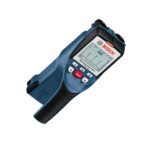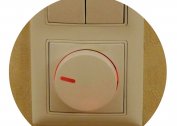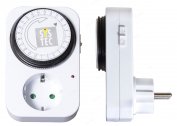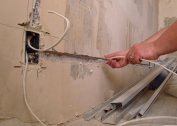Often, inexperienced craftsmen find it difficult to find hidden wiring in the walls. However, one can cope with the task, knowing some of the principles of operation of improvised and special devices.
When you need to find hidden wiring
The search for the cable laid in the wall is performed in such situations:
- Overhaul with redevelopment of the premises. In order not to damage the wires, you need to know their location.
- Displacement of existing power points to other places for a more convenient location of equipment, lamps.
- Breakage of wiring in one of the zones of the room. Here you need to find a problem place and fix the problem.
In case of a complete replacement of the old wiring with a new one, you also need to find the cable so as not to cross with it when laying new plugs or, if necessary, lay other wires in the existing channels.
The benefits of flush-mounted cable
The hidden method of wiring in an apartment or house differs from the outside in that all cables are not visible to the eyes of households and guests. The advantages of this installation method are as follows:
- After finishing the strob with putty, the wall is ready for finishing. The master can arrange the design of the room at his discretion.
- Wires laid in channels are less hazardous to the user than an open cable. Covert communication cannot be damaged by accident.
- When laying the cable by a secret method, use the path from the junction box, which is laid strictly vertically and horizontally. This saves the cost of purchasing the necessary conductive products.
Retro wiring and open cable laying according to SNiP are used in wooden cottages. It is difficult to hide it, because it is contrary to the rules of fire safety.
Special devices for cable search
According to the PUE, the wiring in the wall is laid only directly. Turns are performed at an angle of 90 degrees. Diagonal strobes and channels are strictly prohibited. Therefore, when searching for a cable in the wall, the master, using any kind of device, should only move horizontally or vertically. This is consistent with the logic.
To detect wiring, you can use these types of special devices:
- Electromagnetic finders. Devices respond to a voltage of at least 1 kW inside the walls. Therefore, in order to find the cable, any electric device must first be plugged into the outlet. It can be a microwave, kettle, hairdryer. At the wiring location, the device indicator will light.
- Electrostatic finders. They work during testing according to the same principle as electromagnetic ones - they react with a light, sound signal to the passage of current through the cable.
- Metal detector. The device creates an electromagnetic field when approaching a metal. The disadvantage of this device is that it reacts to any metal in the wall - fittings, screws, wire. You can correct the situation if you use professional models of devices. They additionally show what type of alloy is hidden behind the wall.
- Electrostatic finder
- Electromagnetic finder
- Metal detector
- Indicator screwdriver
Modern searchers have several functions at the same time - metal search, phase determination, etc. Of the most popular are:
- "Search". It works on the principle of electrostatic cable detection. Can find wiring to a depth of 7 cm. It has four sensitivity modes.The device for determining the wiring in the wall "Search" has a budget price and does not belong to the class of professional.
- "Mage-2." This is a combined apparatus that operates on the principle of electrostatic or electromagnetic detection. It responds to the cable found with a sound and light signal. The device can find live wires without it.
- LA 1012. This is a more professional device from the Chinese manufacturer. It uses the electromagnetic search principle.
- BOSH GMS 120. High-precision device from the class of professional. Searches for cable in the wall and other metals. Quickly determines the type of alloy.
- Indicator screwdriver or tester. No less reliable device with which you can determine and even test the functionality of a hidden cable. In addition to the fact that the screwdriver can find the "phase" and "zero", find the conductive line, it also indicates the place of cable breakage in the wall. To detect the wires, a screwdriver is driven along the panels. In the places of the desired channels, the instrument will display a luminous indication.
It is advisable to load the network when working with a screwdriver.
Alternative search methods
To find the wiring in the wall, without special equipment, you can use common methods. They are based on simple logic or the use of improvised tools. Experienced experts recommend the following:
- Visual inspection of the wall after dismantling the wallpaper. As a rule, the strobe location lines differ from gray concrete walls by the presence of stucco strips. If they are all located horizontally and vertically (which is the main condition when laying the channels), only at right angles, this is hidden communication.
- Use of a radio. To do this, set the frequency to 100 kHz on the device. With these indicators, the receiver will respond by increasing noise to the approaching wiring. You need to drive the device along the walls, trying to find the desired lines. The same can be done with a cassette recorder or player. You only have to lengthen the wire coming to the magnetic head. It will have to be removed from the cassette and tipped with wire. The magnetic head here works on the principle of an antenna.
- Using a multimeter. It is advisable to add a field effect transistor to it. Both devices must be connected correctly. The probes of the multimeter are brought to the drain and source of the transistor without observing the polarities. The device is initially set to ohmmeter mode. A piece of wire should be attached to the shutter, which will act as a search antenna. She needs to drive along the walls and track the readings on the multimeter. Any changes in them signal the presence of hidden wiring.
- The use of a hearing aid. Such a determinant must be set to the "telephone" mode and apply a load to the network. The device searches for wiring at a frequency of 50 kHz.
- The use of a compass. To find out where the wiring in the wall goes, you can use a magnetic device. To do this, load the network (for example, include a curling iron in a socket) and drive a compass along the wall. Where the arrow begins to deviate, there is a cable.
Using the above devices gives quite good results.
Methods that do not work
Some craftsmen who do not know how to find a wire in a wall resort to the most absurd methods of detecting a cable. These are:
- The use of a magnet. It is believed that if you use (drive along the panels) a single-charged element tied to a thread, it will react to the cable laid in the wall - it will begin to move like a pendulum. In brick buildings, this method of finding does not exactly work. In panel - the magnet runs the risk of stumbling just on the armature. When searching for wiring from the ceiling, the method will not work at all. It is not possible to achieve magnet oscillation by holding the hanging thread horizontally. Gravity interferes.
- The use of a smartphone.Many models running on the basis of OC Mac or Android, supposedly can be used as a metal detector. There are even special programs for this. One of the most popular is the Metall Detector. Its developers claim that with the help of the application and the magnetic sensor built into the device itself, you can safely find the hidden cable. But this is nothing more than a toy that should not be taken too seriously.
Moving when looking for a hidden cable should always be from a junction box or outlet.
Logical reasoning
Using standard knowledge about the location of the hidden cable, the master can easily find the wiring. In this case, it is worth focusing on such norms and schemes:
- From the outlet or switch, the cable always moves up or toward a larger wall area.
- From the floor and ceiling, the cable is always placed at 15-20 cm. Therefore, you should not look for a line above / below.
- According to SNiP, it is possible to hide at least 40 cm to the sides from gas pipes, batteries, line radiators and strobe.
If you have such knowledge, you can supplement them with logic and find the position of communication in the wall. If the master does not want to take risks, it is better to ring the professionals and entrust the work to them.













